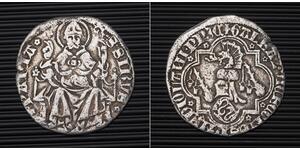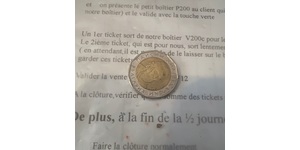1 Grosso (продана за $33.0)
1354-1378, Pavia, Galeazzo II Visconti. Silver Pegione (Grosso = 1½-Soldi) Coin.
Mint Place: Pavia
Ruler: Galeazzo II Visconti
Mint Period: 1354-1378 AD
Condition: Lightly cleaned, otherwise VF.
Denomination: Pegione (Grosso of 1½-Soldi)
Reference: MIR 108, CNI 9-11, Cr.2. Very Rare!
Diameter: 24mm
Weight: 2.36gm
Material: Silver
Obverse: St. Sirus mitred, nimbate, holding crozier in left hand.
Comment: Saint Syrus (Sirus) of Pavia (Italian: San Siro) is traditionally said to have been the first bishop of Pavia during the 1st century.
Legend: .S.SIRVS PAPPIA * *
Reverse: Shield of Milan, topped by a helmet, decorated with a dragon or serpent with a person in its mouth.
Comment: A pair of burning tree-stems with hangin buckets at sides. All within six-foil.
Legend: +GALEAZ.VIECOMES.D.MEDIOLANI.PP.3C.
Pavia is a town and comune of south-western Lombardy, in Northern Italy, 35 kilometres (22 miles) south of Milan on the lower Ticino near its confluence with the Po.
Visconti was the family name of two important Italian noble dynasties of the Middle Ages. Two distinct Visconti families are known: the first one (chronologically) in the Republic of Pisa in the mid twelfth century, who achieved prominence first in Pisa, then in Sardinia, where they became rulers of Gallura; the second and most important one rose to power in Milan, where they left a permanent historical mark ruling the city from 1277 to 1447 and leaving several collateral branches still extant.
The Visconti ruled Milan until the early Renaissance, first as Lords, then, from 1395, with the mighty Gian Galeazzo who almost managed to unify Northern Italy and Tuscany, as Dukes. Visconti rule in Milan ended with the death of Filippo Maria Visconti in 1447. He was succeeded, after a short-lived republic, by his son-in-law Francesco I Sforza, who established the reign of the House of Sforza.
Galeazzo II Visconti (c. 1320 – 4 August 1378) was a member of the Visconti dynasty and a ruler of Milan, Italy.
He was the son of Stefano Visconti and Valentina Doria.
In 1343 he made a pilgrimage to Jerusalem. Two years later he was ousted by his uncle Luchino, returning under archbishop Giovanni Visconti, who made him governor of Bologna.
In 1350 he married Bianca of Savoy, daughter of Aimone, Count of Savoy. Six years later he fought alongside his brother Bernabò against the Este and the Gonzaga, with Pandolfo II Malatesta as commander of his troops. Winner at Casorate, he was able to expand his territories. At the death of his brother Matteo II, Galeazzo obtained the western part of Lombardy, while Bernabò received the eastern one.
He was handsome and distinguished, the patron of Petrarch, the founder of the University of Pavia and a gifted diplomat. He married his daughter Violante to Lionel of Antwerp, son of Edward III of England, giving a dowry of 200,000 gold florins; and his son Gian Galeazzo to Isabelle, daughter of King John of France.
Galeazzo faced several rebellions during his reign. In 1362 his health worsened and he moved his court to Pavia, which he had reconquered two years earlier, and where he died in 1378.
He was infamous for instituting the quaresima, a particularly sadistic form of torture, aping ecclesiastical terminology, which preceded the execution on the wheel of state offenders and lasted forty days, alternating one day of the most atrocius torment and one of rest. Almost invariably the condemned died before being brought to the wheel.

|
Добавив:
anonymous 2024-03-16 |
|
||
|
||
|
||
|
||
9 монет було додано з 2025-06-04 по 2025-06-11
Одна з них:




 English
English











